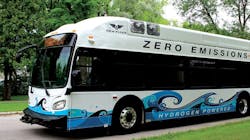Champaign-Urbana MTD unveils new zero-emission fleet technology
At an Oct. 14 event that featured project partners and local, regional and federal stakeholders, the Champaign-Urbana Mass Transit District (MTD) unveiled its first-of-a-kind zero-emission fleet technology.
The new technology includes a newly commissioned, on-site hydrogen production station that is powered by a solar array that spans nearly 5,500 panels. The resulting clean hydrogen fuel powers 60-foot hydrogen fuel cell buses for MTD's transit system, which emit only water vapor, as they serve the cities of Champaign, Urbana, Savoy and the third-largest Big 10 University, the University of Illinois at Urbana-Champaign.
“MTD has always been forward thinking, and this project puts MTD right out on the cutting edge. We invite members of the public and the industries of transportation and energy to learn about our project and celebrate this advancement in climate resiliency,” said Karl Gnadt, MTD managing director/CEO.
MTD has been working to advance its renewable energy efforts with zero-emission technology and sustainable transportation through this mostly grant-funded project defined by public and private partnerships.
MTD says the hydrogen fuel cell electric buses save more than 50,000 gallons of diesel fuel per bus each year, and one bus reduces greenhouse gases up to 135 tons annually. MTD’s zero-emission fleet will operate alongside diesel electric hybrid buses, currently 97 percent of the 114 bus fleet, but will be 100 percent low or no emission in 2022.
Hydrogen fuel cell electric buses bring the power of zero emissions without the stagnancy of recharging. Hydrogen fueling takes no more time than conventional diesel fueling, which enables flexible route and service designs. Hydrogen is non-toxic and is 14 times lighter than air. With rooftop hydrogen fuel tank storage, an unplanned release rises safely in the air at 45 miles per hour, rather than pooling on the ground.
